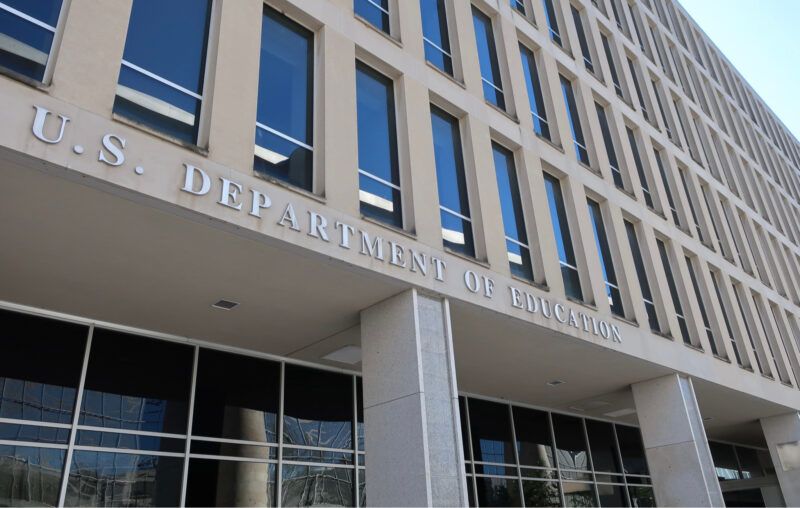Student Loan Forgiveness and the Shifting Standards of the Department of Education

On August 24, 2022, the U.S. Department of Education (DoEd) announced arbitrary amounts of student debt cancellation and arbitrary income cutoffs for eligibility for the cancellation. Borrowers who earn at least $125,000 per year ($250,000 if married or head of household) are completely ineligible for debt cancellation. Among those who are eligible, borrowers who received a Pell Grant at any time in the past qualify for up to $20,000 in cancellation, while those who never had a Pell Grant qualify for no more than $10,000. These arbitrary decisions undermine the legal basis on which the DoEd is relying for mass debt cancellation in the first place.
The DoEd is relying on an August 23 memo from the Department of Justice, which argues that mass debt cancellation is authorized under the HEROES Act of 2003. This law, representing some of the federal grab of emergency powers following the 2001 terrorist attacks, appeared again during the pandemic “emergency.” It was invoked to justify, for example, the pause on student loan repayment (at a cost of $5 billion per month). Now, this law is being used as emergency aid for people with student loans.
Emergency powers under the HEROES Act kick in when the President declares a national emergency. Of course, the Department of Education is delighted to observe that the United States is still in a pandemic “emergency.” That means the Secretary of Education is authorized to waive or modify rules that, for instance, help ensure against waste, fraud, and abuse in the repayment of federal student aid. More than two years into the “emergency,” several rules remain waived, including the rules pertaining to paying one’s debts and accruing interest when not paying one’s debts.
The previous administration considered whether the HEROES Act could justify mass debt cancellation and, fortunately, determined that it cannot. Most importantly, the waiver is limited to “affected individuals” who “suffered direct economic hardship as a direct result” of the “national emergency.” Moreover, the previous administration noted several laws and regulations directing agencies to collect debts, not cancel them.
But the current administration has been thrilled to discover the needed emergency authority in the HEROES Act after all. The administration sees no meaningful difference between delaying the requirement to pay one’s debts, such as already exists in forbearances, and waiving or modifying the requirement to pay one’s debts at all, ever. If mass delays in repayment are allowed because nearly every American with a student loan has been directly affected with economic hardship as a direct result of the pandemic, the argument goes, mass cancellation is allowed because nearly all of the Americans being helped today are still directly affected with economic hardship.
The biggest problem with this argument is that large numbers of these borrowers have no economic hardship due to the pandemic, and many of them never did. Vast numbers of white-collar workers continued to get their paychecks while working from home, and a substantial portion of these workers had student loans. They did not need the repayment pause in the first place, and they need debt cancellation even less today.
The other key problem involves the arbitrary cutoffs in the cancellation plan. On the current (but flawed) reading of the HEROES Act, the Secretary of Education has extremely wide discretion to determine what is “necessary” to provide relief such that those who were harmed by the emergency will not be in a worse financial situation, after all, because of their student loans. Even such wide discretion, however, cannot include such arbitrary decisions. The Justice Department’s memo insists, “the Secretary can use the HEROES Act only to offset that portion of the harm that has a ‘relation to’ the borrower’s title IV assistance.” Yet, without any written discussion, analysis, or notice and comment from the public, the Secretary has declared which borrowers will get what, and which borrowers will get nothing.
In particular:
- There is no reasonable ground to imagine that borrowers who at some time in the past were Pell Grant recipients have financially suffered twice as much from the pandemic compared to borrowers who never received a Pell Grant. It is true that Pell Grant recipients, by and large, more often drop out of college and more often attend two-year colleges, so their lifetime income trajectories are lower. But these differences appear entirely irrelevant to harm related to the pandemic.
- Even if the plan survives that challenge, the $10,000 and $20,000 cancellation figures are drawn out of thin air. The decision was clearly political. The amounts needed to be enough to count as “loan forgiveness” without reaching the politically infeasible $50,000 per borrower or full forgiveness insisted upon by progressive advocates. The amounts are entirely disconnected from the actual economic harms of those who hold student loans. No attempt whatsoever was made to estimate harms.
- Again, Americans’ economic situations are very extremely diverse. Accordingly, there is no justification at all for creating three classes of borrowers. None of the purported classes has anything relevant in common that reflects harm from the pandemic related to federal student aid. The department does not even attempt to explain its division of borrowers into meaningfully separate classes.
- In particular, what magically happens at the $125,000 annual income level such that those borrowers have zero harm from the pandemic? Of course, this decision is also political. It helps avoid the charge that debt forgiveness is regressive, making less educated, less wealthy people pay for the college educations of the more educated, more wealthy, while still providing a perk to the richer among us. (The poorest four states have a median family income around $60,000, just one fourth of the family-income cutoff of $250,000.)
- Furthermore, why are both the Pell and non-Pell classes distinguished from a third class, those with an income of at least $125,000 per year, whether Pell or non-Pell? Does the Pell vs. non-Pell distinction simply disappear at this income level?
- Finally, to justify a continued repayment pause for all borrowers, the current administration must rely on the HEROES Act and show that all borrowers are still being directly harmed by the pandemic “emergency.” If that’s true, the Department of Education must argue and acknowledge that even the wealthier borrowers, those with annual income above $125,000, are being harmed, such that a repayment pause for them remains “necessary.” Well, are they being harmed, or aren’t they? Are they being harmed for the purpose of a repayment pause, but not harmed for the purpose of debt cancellation? That would be absurd, much like the other arbitrary decisions described here.
In sum, the HEROES Act provides no shelter for the arbitrary, capricious, political decisions announced by the Department of Education.
The Department’s full announcement, unfortunately, is even worse. It also proposes major changes to income-driven repayment plans. These are plans that are affordable by definition because they are based on ability to pay. But now they may get even more affordable: After just 10 years of paying only 5 percent of one’s disposable income (redefined so as to exclude even more income), one’s debt will be forgiven. There’s no need to be shy about calling the Department’s plans a new socialism of higher education: pay only what you can, the minimum amount vanishes toward zero, and the taxpayer will cover the rest.










